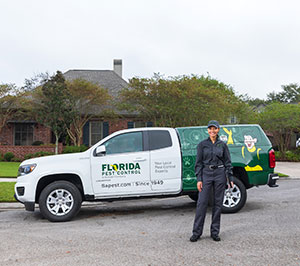Top Quality A1 Pest Control Services Charlotte - Protect Your Home
Top Quality A1 Pest Control Services Charlotte - Protect Your Home
Blog Article
Bed Pest Therapy Failure: Comparing Chemical Vs. Non-Chemical Solutions
In the realm of bug control, especially when dealing with the consistent problem of bed pests, the selection between chemical and non-chemical treatment remedies can be an essential one. Both techniques provide distinct advantages and disadvantages, affecting factors such as efficiency, safety factors to consider, and general price. By analyzing the nuanced information of each method, a more clear understanding of which course to go after in addressing a bed insect problem can be acquired.
Performance of Chemical Treatments
Chemical treatments for bed pest infestations have actually been widely acknowledged for their quick and powerful efficiency in eliminating these bugs. When considering the effectiveness of chemical treatments, it is vital to understand that they can offer a quick and complete option to a bed pest trouble.
Moreover, chemical therapies have the benefit of offering residual results, suggesting that they can remain to get rid of bed bugs also after the preliminary application. This residual action is particularly advantageous in combating any kind of possible re-infestations. Furthermore, the fast action of chemical therapies can bring relief to individuals encountering extreme bed bug problems, permitting them to regain control of their living rooms swiftly.
Security Interest In Chemical Solutions
When making use of chemical solutions for bed bug treatment is ensuring the security of owners and the environment,One critical element that calls for mindful consideration. While chemical treatments can be reliable in eliminating bed bugs, they may present threats if not dealt with effectively. One of the main security problems with chemical remedies is the possible harm they can cause to human health and wellness. Direct exposure to particular chemicals utilized in bed pest therapies can bring about respiratory issues, skin irritability, or other unfavorable reactions, particularly in individuals with pre-existing problems or level of sensitivities. Additionally, improper application or dosage of chemical pesticides can result in harmful deposits lingering in the treated area, presenting long-lasting wellness risks to residents.
Additionally, the environmental impact of chemical solutions is another substantial consideration. Some pesticides made use of in bed pest treatments may be hazardous to useful pests, wildlife, and communities if they leach right into the dirt or water supply. It is necessary to use chemical therapies carefully, following safety and security standards, and thinking about much less hazardous options to minimize these dangers and ensure the reliable and safe monitoring of bed insect problems.
Benefits of Non-Chemical Strategies
Thinking about the potential security concerns and ecological impact connected with chemical options for bed bug therapy, exploring non-chemical techniques offers an appealing option with several unique advantages. Non-chemical methods use a more secure choice for houses, especially those with people, kids, or pets sensitive to harsh chemicals. These strategies eliminate the dangers of exposure to toxic substances, lowering the possibility for unfavorable wellness impacts. In addition, non-chemical treatments are eco pleasant, as they do not contribute to air or water pollution, making them a sustainable option for bug control.
Furthermore, non-chemical solutions can be effective in targeting bed bugs, consisting of hard-to-reach locations where chemical therapies might not penetrate. Approaches such as heat treatment, vacuuming, vapor cleansing, and mattress encasements give comprehensive elimination without the use of hazardous chemicals. Furthermore, non-chemical methods can be much less turbulent, requiring minimal prep work and enabling quicker reentry right into treated locations. Overall, going with non-chemical bed insect treatment methods not just prioritizes safety and environmental security yet also makes certain reliable and detailed bug control.
Limitations of Non-Chemical Treatments

Furthermore, non-chemical treatments usually call for several applications to attain successful obliteration. This can be taxing and may not always assure full removal of all bed bugs and their eggs, specifically in concealed or hard-to-reach places.
Furthermore, the success of non-chemical therapies heavily relies upon correct implementation and thoroughness, which can be testing for individuals without specialist knowledge. Inadequate application of non-chemical methods might lead to incomplete obliteration, leading to consistent problems and the need for extra therapies.
For that reason, while non-chemical therapies have their benefits, it is necessary to acknowledge these restrictions and consider them when figuring out one of the most effective method for managing bed insect problems.
Cost Comparison: Chemical Vs. Non-Chemical Options
Provided the limitations associated with non-chemical therapies, an important aspect to assess in the context of bed bug management is A1 bed bug exterminator charlotte the price comparison in between chemical and non-chemical alternatives. In contrast, non-chemical therapies like warmth therapy or vapor can be more expensive, with prices ranging from $1,000 to $6,000 for a whole home. While the first expense of chemical treatments might seem reduced, multiple therapies might be required to totally remove the infestation, potentially increasing the total expense.
Verdict

Considering the possible safety concerns and ecological influence connected with chemical solutions for bed pest treatment, exploring non-chemical approaches provides a promising choice with a number of distinct advantages.Given the limitations associated with non-chemical therapies, an essential facet to examine in the context of bed bug management is the price contrast between chemical and non-chemical alternatives. In contrast, non-chemical therapies like heat therapy or steam can be much more pricey, with expenses varying from $1,000 to $6,000 for an entire home. While the preliminary price of chemical treatments might seem reduced, multiple therapies might be required to completely eliminate the problem, potentially enhancing the total cost.In final thought, when comparing chemical and non-chemical bed pest treatment choices, it is vital to take into consideration efficiency, safety, advantages, constraints, and cost.
Report this page